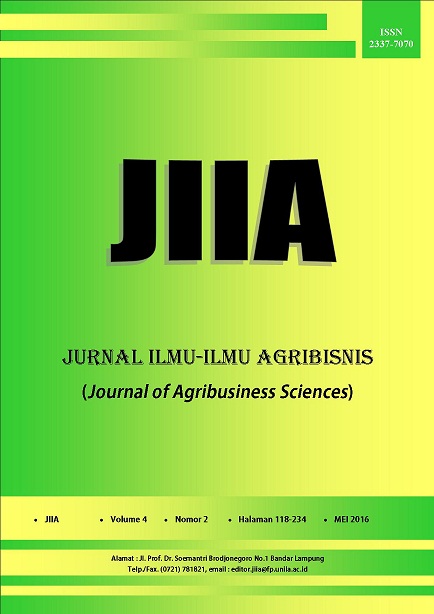PENDAPATAN DAN MANFAAT USAHATANI PADI ORGANIK DI KABUPATEN PRINGSEWU
DOI:
https://doi.org/10.23960/jiia.v4i2.1229 Abstract View: 3813
Abstract View: 3813
Abstract
Pesticide and chemical fertilizer usage in rice farming is known to deteriorate soil and environment. Organic rice farming is developed. However, there are not many farmers who cultivate organic compared to nonorganic rice. The objectives of this research are to analyze the cost, production, the income of organic and nonorganic rice farming, and to explore the benefits of organic rice farming. This research was conducted in Pringsewu Regency in August 2015. The sampling method employed was a census on 30 farmers cultivating organic rice in two villages, and simple random of 30 farmers cultivating nonorganic rice. Data were analyzed using farming analysis and descriptive qualitative. The results showed that organic rice production (6,587 kg per ha) was lower than nonorganic rice production (6,630 kg per ha in two planting seasons). The production cost of organic rice farming was higher (Rp39,011,679.00 per ha) than that of nonorganic rice farming (Rp30,326,937.00 per ha in two planting seasons). Income of organic rice farming was higher than nonorganic, Rp50,759,725.00 and Rp24,454,808.00 respectively. Organic rice farming was more profitable than nonorganic rice farming with the R/C on the total cost of organic rice farming of 2.30 and nonorganic rice farming of 1.81. The B/C was 3.03. In addition to economic benefit, farmers of organic rice obtained social benefits such as providing job field and farmer groups’ activity. Environmental benefits that were obtained by farmer were reducing dependence on chemicals and creating a secure work environment for farmers.
Key words: benefit, organic rice, production, profitDownloads
Downloads
Published
How to Cite
Issue
Section
License
Authors who publish with this journal agree to the following terms:
Authors retain copyright and grant the journal right of first publication with the work simultaneously licensed under a Creative Commons Attribution License that allows others to share the work with an acknowledgement of the work's authorship and initial publication in this journal.
Authors are able to enter into separate, additional contractual arrangements for the non-exclusive distribution of the journal's published version of the work (e.g., post it to an institutional repository or publish it in a book), with an acknowledgement of its initial publication in this journal.
Authors are permitted and encouraged to post their work online (e.g., in institutional repositories or on their website) prior to and during the submission process, as it can lead to productive exchanges, as well as earlier and greater citation of published work (See The Effect of Open Access).














